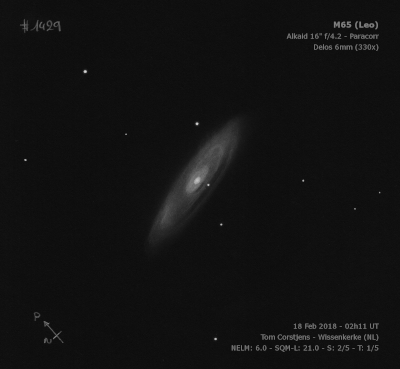
Charles Messier discovered M65 = NGC 3623 = h854, along with M66, on 1 Mar 1780. William Herschel first observed it on 31 May 1783 with his 12-inch and noted "almost a certainty of its being stars. There is however in both the nebulas [65 and 66] a certain whitishness left which may be nebulosity." With his 20-ft scope (18.7-inch), he recorded "a very brilliant nebula extended in the meridian, about 12' long. It has a bright nucleus, the light of which suddenly diminishes on its border, and two opposite very faint branches."
Lord Rosse first observed M65 on 31 Mar 1848 and called it a "Curious nebula with bright nucleus at left a little above and towards the right is a streak spiral; resolved very well about the nucleus, but no other part. From the right, and apparently springing from the nucleus, a very faint portion of nebulosity extends for about 15', gradually melting away. William Rambaut (LdR's assistant) sketch on this night was published in the 1850 PT paper (plate XXXVII, fig. 7). On 25 Feb 1854, "Lord Rosse suspected dark spaces on either side of the nucleus.", though this suspicion wasn't confirmed the following year. William Lassell also sketched M65 using the 48" from Malta.
300/350mm - 13.1" (4/10/86): very bright, elongated N-S, elongated bright core, possible stellar nucleus.
400/500mm - 17.5" (1/31/87): very bright, very large, very elongated N-S, 7.5'x2.0', bright core, stellar nucleus. A mag 12 star is west of the south end 2.1' from the center. Forms a remarkable trio with M66 20' ESE and NGC 3628 36' NE. Requires low power (31 Nagler) to easily fit all three in the same field.
900/1200mm - 48" (5/1/19): at 375x; beautiful, extremely large, showpiece spiral extending 7:2 N-S. The galaxy displayed a strong concentration with a very bright, round core and an intensely bright, prominent nucleus. There was a slight enhancement along the major axis but no impression of a bar. A long, low contrast dust lane runs N-S along the length of the galaxy on the east side. The edge was a bit ragged and the glow of the galaxy on its east side had a low surface brightness. A mag 14.5 star is at the W edge of the dust lane, due east of the core. Also a mag 16 star is at the W edge of the galaxy, slightly south of the nucleus [1.2' WSW of the mag 14.5 star]. A mag 12.3 star is 2.3' SSW of center, just off the W side.
Notes by Steve Gottlieb